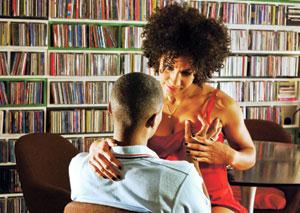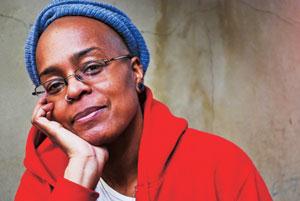
Still from Stud Life.
When you think of a masculine queer, who do you picture? A buff gym queen? A bear? Maybe a butch dyke sporting a fauxhawk and a sweater vest?
Masculinity has a much broader scope and needs to be better represented, which is why London-based director Campbell X decided to make her newest film, Stud Life.
“The idea came from wanting to recreate a world that I see in London all the time but that I never see on film,” X says. “To have a masculine-of-centre person as the central character, but also to show multicultural London. To make a film that was queer and multicultural and tells a good story.”
The film leads viewers through the tumultuous love story of a femme named Elle and a stud named JJ, whose gay best friend Seb is her wingman and confidant.
“I’ve always dealt with stud/femme dynamics in my films. It’s something that you rarely see in television or cinema,” X says. “You don’t see studs as complex characters, and they don’t occupy central frames. And, normally, there’s a kind of feminized image of lesbians or bisexual women in cinema and TV, but they’re not femmes.”
Portraying the desire between studs and femmes interested X — the femme gaze, in particular.
“Femme lesbians, especially those who desire studs, are kind of outside of the mainstream. Who they desire is quote unquote undesirable. Their gaze is very subversive in lots of ways because they create beauty by looking at a stud who is very rarely seen in a positive, interesting way onscreen. Their gaze is a powerful one.”
What about the stud gaze toward femmes?
“I think that gaze is much more acceptable in a way. It’s easy because it sort of slots into dominant views of womanhood. The feminine woman is often portrayed as the desirable woman, irrespective of her sexuality.”
One of the rare and amazing things about Stud Life is its exploration of a stud’s self-gaze. In vignettes that depict JJ making off-the-cuff YouTube videos about her life, we see her talking about her experiences and identity.
“There are very few images of studs in TV or cinema,” X says. “But I found so many studs on YouTube. There are studs that are just sort of chatting to the internet — discussing things, you know? Issues that are relevant to their lives. They’ve bypassed the mainstream media, saying, ‘I don’t even need you. I’m talking to my people directly. I’m talking about my concerns.’”
While the mainstream is, for the most part, not engaging with stud culture, studs are engaging with each other — and making those conversations accessible to the wider world through social media platforms like YouTube.
“I was very inspired by that because, in a way, they’re also creating an archive online of 21st-century queerdom. There are a lot of queer people of colour [doing that], and that’s also significant. You hardly see them in mainstream or even independent films, but they’re on YouTube. Taking up that space to be, to show themselves, to be visible and proud.”
Stud visibility is a cornerstone of X’s new film.
“I use the word stud because I want people to know that there is something else besides butch,” she says. “Often the assumption is that white gay culture is gay culture. Like, white, European culture is universal and everybody slots into it. I think people forget the specificity of white in the dominant culture. It’s a culture, not the culture.”
Underlying the main story of Stud Life, there is a persistent threat of violence and how that can penetrate into loving relationships.
“I wanted to show the textures of violence that we all have to deal with,” X says. “There’s consensual violence, which is about kink and play, and I wanted to normalize that, in a way. To show that that’s part of the sexual repertoire. The [external] violence is about how we live happy, metropolitan lives, but random stuff can happen. Random violence. The violence inside [the relationship] . . . I think that happens more than we acknowledge. And how do you come back from that? From hitting somebody who you say you love?”
A number of other issues are touched upon, as well: internalized homophobia, social friction between friends and lovers, and the sexual complications that can come up in relationships.
“I wanted to problematize lesbian sex because I think there’s a myth that lesbian sex is easy. Like, once you fall into bed with a woman, it’s going to be perfect because she’s a woman and you’re a woman and you’ve got the same bits, so you know what to do. That’s not really true,” says X, who decided to make the character of JJ a stone stud. “Sometimes, there are difficult conversations to be had around desire and parts of the body. It’s not that simple. That’s a conversation that some femmes have to have with some studs about boundaries — where to touch and where not to touch. For studs, there will always be that kind of conversation. I wanted to put that in the film because we never see that about ourselves.”

 Why you can trust Xtra
Why you can trust Xtra


